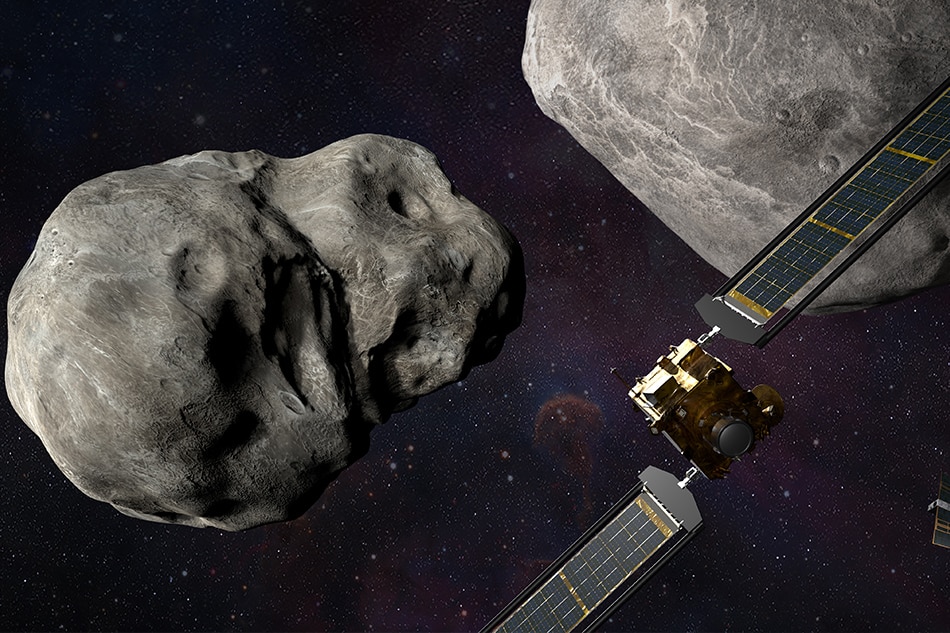NASA gears up to deflect asteroid in key test
ADVERTISEMENT

Welcome, Kapamilya! We use cookies to improve your browsing experience. Continuing to use this site means you agree to our use of cookies. Tell me more!
NASA gears up to deflect asteroid in key test
Deutsche Welle
Published Sep 27, 2022 04:00 AM PHT
NASA will make its first attempt to crash into an asteroid on September 26 or September 27, depending on where you live in the world.
NASA will make its first attempt to crash into an asteroid on September 26 or September 27, depending on where you live in the world.
The collision will mark the end of the DART mission, a 10-month space journey to autonomously deflect a non-hazardous asteroid. But it will also be the start of masses of new data in what scientists call "planetary defense."
The collision will mark the end of the DART mission, a 10-month space journey to autonomously deflect a non-hazardous asteroid. But it will also be the start of masses of new data in what scientists call "planetary defense."
DART will slam into Dimorphos, an asteroid of around 160 meters (525 feet) in diameter which orbits Didymos, another, larger asteroid of around 780 meters in diameter.
DART will slam into Dimorphos, an asteroid of around 160 meters (525 feet) in diameter which orbits Didymos, another, larger asteroid of around 780 meters in diameter.
DART stands for Double Asteroid Redirection Test.
DART stands for Double Asteroid Redirection Test.
ADVERTISEMENT
Test mission to deflect an asteroid
"This is just a test," said Nancy Chabot, the DART coordination lead at Johns Hopkins Applied Physics Laboratory during a press briefing on September 15. "This asteroid is not a threat to the Earth. In fact, there are no known asteroid threats to the Earth for the foreseeable future."
"This is just a test," said Nancy Chabot, the DART coordination lead at Johns Hopkins Applied Physics Laboratory during a press briefing on September 15. "This asteroid is not a threat to the Earth. In fact, there are no known asteroid threats to the Earth for the foreseeable future."
There are still asteroids that scientists have yet to find. But Chabot said they wanted to do this test now "to be ready for when we might potentially need it."
There are still asteroids that scientists have yet to find. But Chabot said they wanted to do this test now "to be ready for when we might potentially need it."
10-month 'cruise' to Dimorphos
The DART spacecraft launched on November 24, 2021, on a 10-month "cruise" toward the pair of asteroids called Dimorphos and Didymos.
The DART spacecraft launched on November 24, 2021, on a 10-month "cruise" toward the pair of asteroids called Dimorphos and Didymos.
At 23:14 UTC on September 26, DART will crash into Dimorphos at roughly 6.1 kilometers per second (3.8 miles per second).
At 23:14 UTC on September 26, DART will crash into Dimorphos at roughly 6.1 kilometers per second (3.8 miles per second).
Dimorphos will be about 11 million kilometers (6.8 million miles) from Earth at the time of DART's impact.
Dimorphos will be about 11 million kilometers (6.8 million miles) from Earth at the time of DART's impact.
ADVERTISEMENT
As DART gets closer and closer to the asteroid, we will be able to see a stream of live images. Then at the time of impact, another, Italian-made spacecraft, called LICIACube, will film the impact from the side.
As DART gets closer and closer to the asteroid, we will be able to see a stream of live images. Then at the time of impact, another, Italian-made spacecraft, called LICIACube, will film the impact from the side.
"Crashing this small spacecraft [DART] into a much larger asteroid is only going to cause a small change in how Dimorphos goes around Didymos. The change will only be about 1%. That makes this a very safe and efficient way to do this test."
"Crashing this small spacecraft [DART] into a much larger asteroid is only going to cause a small change in how Dimorphos goes around Didymos. The change will only be about 1%. That makes this a very safe and efficient way to do this test."
DART faces many technological challenges
The DART mission won't distinguish between the two asteroids until the final hour before impact. It will use images from an onboard camera to autonomously identify Didymos and Dimorphos and then — also autonomously — fire thrusters to make sure it stays on an "intercept course with Dimorphos."
The DART mission won't distinguish between the two asteroids until the final hour before impact. It will use images from an onboard camera to autonomously identify Didymos and Dimorphos and then — also autonomously — fire thrusters to make sure it stays on an "intercept course with Dimorphos."
"These algorithms are [among the main technologies] being demonstrated by DART," said Chabot.
"These algorithms are [among the main technologies] being demonstrated by DART," said Chabot.
They are called SMART Nav and were developed at the Johns Hopkins Applied Physics Laboratory.
They are called SMART Nav and were developed at the Johns Hopkins Applied Physics Laboratory.
ADVERTISEMENT
"It's autonomous navigation that uses these images to ensure you can target a small asteroid in space, accurately, and it's one of the main challenges," said Chabot.
"It's autonomous navigation that uses these images to ensure you can target a small asteroid in space, accurately, and it's one of the main challenges," said Chabot.
These very same images will be streaming back to Earth at one per second and shown live on a NASA broadcast.
These very same images will be streaming back to Earth at one per second and shown live on a NASA broadcast.
How big is the threat from asteroids to Earth?
The asteroid that wiped out the dinosaurs was about 10 kilometers (6.2 miles) in size.
The asteroid that wiped out the dinosaurs was about 10 kilometers (6.2 miles) in size.
"That sort of asteroid changed the whole planet, but we don't know of any asteroid of that size today," said Thomas Zurbuchen, associate administrator at NASA's Science Mission Directorate, in an interview with DW in November 2021.
"That sort of asteroid changed the whole planet, but we don't know of any asteroid of that size today," said Thomas Zurbuchen, associate administrator at NASA's Science Mission Directorate, in an interview with DW in November 2021.
"If a 160-meter asteroid [like Dimorphos] hits a city, it will a bad day for that city, leaving a crater of more than a kilometer, but it won't change the whole planet" he said.
"If a 160-meter asteroid [like Dimorphos] hits a city, it will a bad day for that city, leaving a crater of more than a kilometer, but it won't change the whole planet" he said.
ADVERTISEMENT
However, Zurbuchen said bombardments by smaller asteroids are a much bigger threat to life on Earth.
However, Zurbuchen said bombardments by smaller asteroids are a much bigger threat to life on Earth.
"We've had a similar bombardment from asteroids over millions of years, but you just don't see it because we have such an active geology on Earth," Zurbuchen said.
"We've had a similar bombardment from asteroids over millions of years, but you just don't see it because we have such an active geology on Earth," Zurbuchen said.
DART will be the first test of future planetary defense against asteroid bombardments.
DART will be the first test of future planetary defense against asteroid bombardments.
First of future missions
The European Space Agency said Dimorphos will be the first object in the solar system to have its orbit shifted by human effort in a measurable way.
The European Space Agency said Dimorphos will be the first object in the solar system to have its orbit shifted by human effort in a measurable way.
ESA is looking ahead to its own mission to study Dimorphos up close. It will use a spacecraft called HERA, which is planned for launch in 2024.
ESA is looking ahead to its own mission to study Dimorphos up close. It will use a spacecraft called HERA, which is planned for launch in 2024.
ADVERTISEMENT
Meanwhile, China is also reportedly planning a planetary defense mission for 2026.
Meanwhile, China is also reportedly planning a planetary defense mission for 2026.
Edited by: Zulfikar Abbany
ADVERTISEMENT
ADVERTISEMENT



